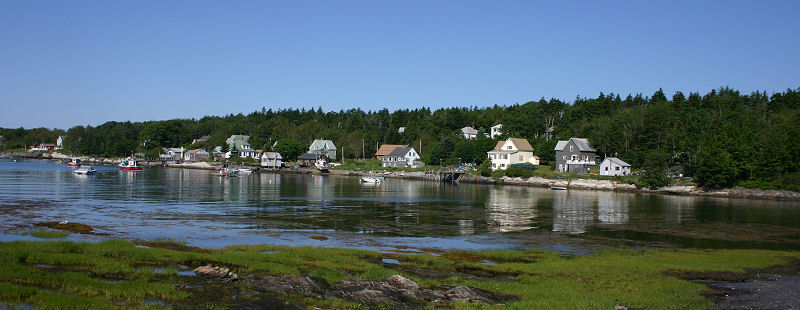[Jen's paternal GGrandparents]
[Marylou Holt > grandson of 5 & 6, granddaughter of 7 & 8]
William Elliott Holt
BIRTH: 06 September 1907, Lewiston, Androscoggin, Maine
DEATH: 17 April 1951
Terena Elizabeth Griffin
BIRTH: 10 January 1915, Portland, Cumberland, Maine
DEATH: 07 April 1997, Brunswick, Maine
William Elliott Holt
William E Holt born in 1907, the oldest of the children of Roxcillana Elliot Holt (1892-1939) and Arthur Holt (1882-1951) at Lewiston. They had married in Mechanic Falls, Maine in 1906, when Roxcillana was 14 years old, and Arthur was 24. At the time of William's birth, Arthur was employed as a shoemaker in Lewiston, working as a "blacker". They were renting a house on
Spring Street, the fourth family counted on the Census beyond Maple Street. They were recorded to be unemployed for half the year during 1909.
 |
| abt 1916: Four Generations: Emma Melissa Parsons(1871-1925), Roxcillana
Elliott(1892-1939), Abby Adeline Wardwell (1852-1926), and William Holt
(1907-1989). |
Siblings of William
1. William Elliott (1907-1989) m 1930 Terena Elizabeth Griffin (1915-1997)
2. Evelyn M (1924-??) (uncertain marriage? m 1943 Forney m 1947 Brown)
3. Frederick A (1926-living) (uncertain marriage? Sawyer('45), Smith('64), Allan('54) ??)
4. Emma (1932-living) m John A Gasper (1930-2001)
5. Dorothy ( 1933-2014) m. Charles R York (1929-1994)
After William was born, his parents waited about 15 years to have more children. In 1920, the Holts lived at
25 Mill Street in Bridgeton Village (across from Elm St off of Main St). Arthur had been working as dyer at the woolen mill there. Meanwhile, William finished the 8th grade, but did not do any years of high school.
By 1930, the family had moved from the rural life to work for the City of Portland as a painter in the street department. They lived at
24 Colonial Avenue, Portland. William would eventually take a job with the same department, also working for the public works department. At the time, William lived with his parents and two younger siblings Evelyn and Frederick, with the Brackleys. (Robert L or Martha A are married, and claim Roxie as a sister! {This is unclear to me, from the historical records.})
Terena Elizabeth Griffin
Terena Elizabeth Griffin was born in 1915, also the oldest child. Her parents, Stephen Harold Griffin (1889-1933) and Terena Elizabeth Dyer (1897-1967) were married in 1912 in Portland, and were both from fishing families on Cliff Island, Portland, Maine. Terena's father Stephen had registered for the draft in 1917, but filed for a religious exemption. In 1920, her parents were renting a house next door to her grandparents. Her dad was a self-employed fisherman. At some point before 1930, Terena Elizabeth Griffin's parents moved to the East End of Portland to work at the fish market, and rented an apartment at
6 Monument Street for $15 a month for them and their four kids. Terena E finished the 8th grade.
Terena's Siblings
1. Terena Elizabeth (1915-1997) m 1930 William E Holt
2. Stephen A (1917-1930)
3. David F (1927-2007)
Life together
William E (23) had married Terena Griffin (15) on October 9, 1930, and had moved to
82 Myrtle Street, Portland. Terena's father passed away in 1933, and the following year, her mother married Stephen's first cousin, Dwinal.
According to the 1940 Census, William was a sign painter. Over the course of their marriage, William E and Terena E had four children:
1. Wilma Louise (1932),
2. William Elliott Jr. (1934),
3. Mary Lou (1937),
4. Elizabeth Lee (1939).
In 1940, William was still working as a painter in the Portland Public Works department (making $1061 in 1939).
William died in 1989 in Brunswick, Maine.
Terena died in 1997 in Brunswick, Maine.
Terena's Obituary:
Terena E. Holt Clark, 82, of Lawrence Street died Wednesday in a Brunswick hospital.
She
was born in Portland, a daughter of Steven Harold and Elizabeth Dyer
Griffin, attended Portland High School and graduated from Southen Maine
Vocational Technical Institute's School of Nursing.
Mrs. Clark, a
licensed practical nurse, worked several years at Maine Medical Center.
She was an active member of the SeventhDay Adventist Church of
Brunswick, and was a volunteer with Dorcas.
Her first husband, William E. Holt Sr., died in 1989.
Surviving
are her husband, Fred Clark; a son, William E. Holt Jr. of Poland;
three daughters, Wilma Louise Clifford of Sweden, Mary Lou Ishihara of
Portland and Elizabeth Lee Shackett of Sterling, Mass.; a brother, David
F. Griffin of Westbrook; four half-brothers, Dwinal of Standish, Alan
of Casco, Theodore of Naples and Clifford Griffin of Auburn; a
half-sister, Caroline Collins of Turner; seven grandchildren and 11
great-grandchildren.
Visiting hours will be from 7 to 9 p.m.
today at Jones, Rich & Hutchins Funeral Home, 190 Woodford St.,
Portland, where a funeral will be held at 10 a.m. Friday. Burial will
follow in Forest City Cemetery, South Portland.
Portland Newspapers Apr 10, 1997







